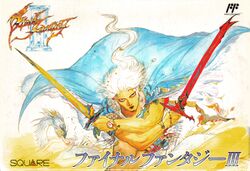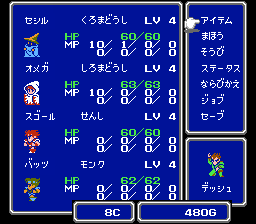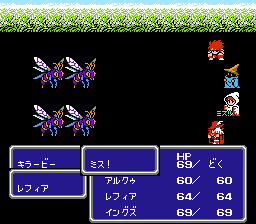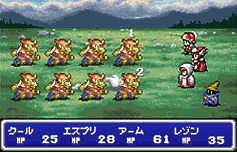The wiki is lacking in content. You can help by creating a new article. See the to do list for more ways you can help.
New user registration has been restored. Thank you for your patience.
Welcome Indie Wiki Jammers! Check out here for info on the jam
Final Fantasy III

|
This article is in need of more sections. You can help the Final Fantasy Wiki by adding sections on the following subjects:
|
| Final Fantasy III | |
|---|---|
 Famicom box art | |
|
ファイナルファンタジーIII | |
| Developer(s): | |
| Publisher(s): |
Square |
| Platform(s): |
Family Computer, Virtual Console (Wii, Nintendo 3DS, Wii U), Nintendo Classic Mini: Family Computer |
| Release date: |
Famicom: |
| Genre: |
Role-playing game |
| Modes: |
Single player |
| Ratings: |
CERO: A (Virtual Console) |
| This article is about the third installment of the Final Fantasy series. For information on the 3D remake, see Final Fantasy III (3D remake). For the game originally titled Final Fantasy III in North America, see Final Fantasy VI. |
Final Fantasy III is the third installment of the Final Fantasy series. It was developed and published by Square and originally released for the Famicom, exclusively in Japan. The third Final Fantasy installment that was released in North America is the sixth overall installment, Final Fantasy VI, and to reflect this, the game was originally titled Final Fantasy III in North America. The game is notable for being the first to have moogles.
The story revolves around four orphaned youths, who are drawn to a crystal of light. The crystal grants them a portion of its power, and instructs them to go forth and restore balance to the world. Not knowing what to make of the crystal's pronouncements, but nonetheless recognizing the importance of its words, the four inform their adoptive families of their mission and set out to explore and bring back balance to the world.
In 2006, the game received a remake for the Nintendo DS, which itself has been ported on several systems.
The game has been re-released in Japan on the Virtual Console service for Wii, Nintendo 3DS, and Wii U. It was also one of the games featured on the Nintendo Classic Mini: Family Computer, but, owing to the Famicom version's Japanese exclusivity, it was replaced by Final Fantasy in international editions.
Gameplay[edit]


The gameplay of Final Fantasy III combines elements of the first two Final Fantasy games with new features. The turn-based combat system remains in place from the first two games, but hit points are now shown above the target following attacks or healing actions, rather than captioned as in the original versions of the previous two games. Auto-targeting for physical attacks after a friendly or enemy unit is killed is also featured for the first time. Unlike subsequent games, however, magical attacks are not auto-targeted in the same fashion.
The experience point system featured in Final Fantasy makes a return following its absence from Final Fantasy II. The character class system featured in the first game in the franchise also reappears, with some modifications. Whereas, in the original game, the player chooses each character's class alignment at the start of the game, Final Fantasy III introduces the "job system" for which the series would become famous. Jobs are presented as interchangeable classes: in the Famicom version of the game, all four characters begin as "Onion Knights," with a variety of additional jobs becoming available as the game progresses. Any playable character has access to every currently available job. Switching jobs consumes "capacity points," which are awarded to the entire party following every battle, much like gil. Different weapons, armor and accessories, and magic spells are utilized by each job. A character's level of proficiency at a particular job increases the longer the character remains with that job. Higher job levels increase the battle statistics of the character and reduce the cost in capacity points to switch to that job.
Final Fantasy III is the first game in the series to feature special battle commands such as "Steal" or "Jump," each of which is associated with a particular job ("Steal" is the Thief's specialty, while "Jump" is the Dragoon's forte). Certain jobs also featured innate, non-battle abilities, such as the Thief's ability to open passages that would otherwise require a special key item. It is also the first game in the series to feature summoned creatures and called with the Summon skill.
Characters[edit]
Classes[edit]
- Warrior-type jobs
- Onion Knight
- Fighter
- Monk
- Archer
- Knight
- Thief
- Dragon Knight (a.k.a. Dragoon)
- Viking
- Karate Master
- Mystic Knight
- Ninja
- Mage-type jobs
Development[edit]
Nintendo Family Computer[edit]
Director Hironobu Sakaguchi, designer Hiromichi Tanaka, character designer Yoshitaka Amano, scenario writer Kenji Terada, and music composer Nobuo Uematsu returned from the two previous Final Fantasy games to contribute to the development of Final Fantasy III. As with the previous two installments of the series, Final Fantasy III was programmed for the Famicom by Nasir Gebelli. It was the last original Final Fantasy title worked on by Gebelli. The finished game was one of the largest ever produced for the Famicom hardware. Like many console role-playing games of the era, Final Fantasy III is remembered for its difficulty.[1]
Square developed and released Final Fantasy III during the same period as Nintendo released its 16-bit Super Famicom console, intended as the successor to the original, 8-bit Famicom. Designer Hiromichi Tanaka attributes the fact that the original game was never released outside of Japan to Square's focus on developing for Nintendo's new console:
- "Nowadays we know that when you've got a platform like PlayStation, you'll have PlayStation 2 and then PlayStation 3, and where you've got Xbox, you move on to Xbox 360 - you can sort of assume what's going to happen in the future. But back then, that was the first time that we'd seen a new generation of consoles, and it was really difficult to predict what was going to happen. At that time, then, we were working so hard to catch up on the new technology that we didn't have enough manpower to work on an English version of Final Fantasy III'"
- —Hiromichi Tanaka[1]
Cancelled WonderSwan Color remake[edit]

In 2000, Bandai unveiled the WonderSwan Color, and had immediately headed up a deal with Square to release enhanced remakes of their first three Final Fantasy titles on the new console.[2] Although Final Fantasy and Final Fantasy II were both released within a year of the announcement, Final Fantasy III was ultimately delayed from its late 2001 release date, even after Bandai picked up the game's publishing rights.[3] While a port of Final Fantasy IV was eventually released for the WonderSwan Color, Square remained silent regarding Final Fantasy III. Although the game was never formally cancelled, the official website was taken offline once production of the WonderSwan Color consoles ceased in 2002.[4]
In 2007, Hiromichi Tanaka explained in an interview that the WonderSwan Color remake had been abandoned because the size and structure of the coding of the original Famicom game was too difficult to recreate on the WonderSwan Color:
- "When we developed FF3, the volume of content in the game was so huge that the cartridge was completely full, and when new platforms emerged, there simply wasn't enough storage space available for an update of FF3, because that would have required new graphics, music and other content. There was also a difficulty with how much manpower it would take to remake all of that content."
Nintendo DS[edit]
- Main article: Final Fantasy III (3D remake)
Following the failure of the effort to remake the game for the WonderSwan Color, and Square's merger with former competitor Enix to form Square Enix in 2003, the company assured that the game's remake would not be completely forgotten, and there was speculation that it might find its way to Sony's PlayStation or Nintendo's Game Boy Advance as its predecessors had.[5][6] Square Enix considered porting the game to the PlayStation 2, but was eventually convinced by Nintendo to develop the title for their new handheld system, the Nintendo DS, a decision that would later be positively reinforced by the commercial success of the Nintendo DS.[7] The Final Fantasy III remake was first announced to be in development on October 24, 2004, but detailed information did not emerge until a year later.[citation needed] Hiromichi Tanaka headed the project as both the executive producer and director. His guidance and supervision were needed because the remake was not a mere graphical update as Final Fantasy and Final Fantasy II's remakes were, but a total overhaul using the Nintendo DS's 3D capabilities. Along with 3D graphics, a full motion video opening scene was produced for the game, similar to those found in the ports of the 2D Final Fantasy games for the PlayStation. Developer Matrix Software handled the programming of the game.
The remake was produced by Tomoya Asano and co-developed by Matrix Software and Square Enix. In addition, Ryosuke Aiba (Final Fantasy XI) was the art director. Akihiko Yoshida (Final Fantasy XII) redesigned the original characters for use in 3D, and designed the looks of the new playable characters. The formerly generic and nameless party characters were given new default names: Luneth (Runesu), Arc (Arukū), Refia (Refia) and Ingus (Inguzu). They were given new personalities and background stories, and additional scenes were added to develop their individuality; however, the main storyline was not altered significantly. Along with these four, additional characters (called "sub-characters") also join the party temporarily, like in the original. Unlike the original however, these characters may randomly participate in battle.
References in other games[edit]
- Chocobo Racing - Several songs were reused, including the opening theme ("Crystal Cave") and the final battle theme.
References[edit]
- ^ a b Fantasy Reborn Interview - Page 1. Eurogamer (archived). Published March 13, 2007.
- ^ "Final Fantasy Goes WonderSwan Color". IGN. Published September 9, 2000.
- ^ "Final Fantasy III Still WonderSwan Bound". RPGamer. Published March 6, 2003.
- ^ "WSC FFIII Vanishes, FFI-II Remake In The Works". RPGFan. Published July 14, 2002.
- ^ "Final Fantasy III Finally On Deck". RPGamer (archived). Published July 7, 2003.
- ^ "Final Fantasy III (DS) (Nintendo DS) Preview". Cubed3. Published August 5, 2006.
- ^ "TGS 2006: Square on Final Fantasy III". IGN. Published September 25, 2006.
External links[edit]
- NES Version on Final Fantasy Kingdom
- Final Fantsy III on TV Tropes Wiki
| This article uses content from Wikipedia (view authors), and falls under the compatible Creative Commons license. |
 This article is a stub. You can help the Final Fantasy Wiki by expanding it.
This article is a stub. You can help the Final Fantasy Wiki by expanding it.